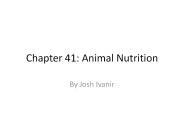Chapter 21: Nutritional Contributions of Minerals to Humans and Animals - PowerPoint PPT Presentation
1 / 23
Title:
Chapter 21: Nutritional Contributions of Minerals to Humans and Animals
Description:
Title: Chapter 1: Animal Agriculture Author: dKenealy Last modified by: student Created Date: 6/6/2002 5:38:29 PM Document presentation format: On-screen Show – PowerPoint PPT presentation
Number of Views:141
Avg rating:3.0/5.0
Title: Chapter 21: Nutritional Contributions of Minerals to Humans and Animals
1
Chapter 21 Nutritional Contributions of Minerals
to Humans and Animals
- Chapter overview
- Chapter 21 presents the impacts of minerals on
animal health - identification and major sources of minerals
- functions of minerals
- impacts of mineral deficiencies
2
General Comments
- There appears to be little difference in
requirements for the minerals between species - Requirements can be significantly impacted by
other organic or inorganic components of the diet - Example phytin binds phosphorus and increases
zinc requirement
3
General Comments
- Minerals are abundant in many natural feedstuffs,
but - Supplementation of feeds and foods with common
inorganic major sources of minerals is typical
4
The Minerals
- Minerals are generally categorized as
- Macrominerals those required in larger amounts,
such as Ca, P, Mg, Na, Cl, K, S - example calcium requirement may be 0.5 in some
diets - Microminerals those required in very small
amounts, such as Fe, Cu, I, Co, Zn, Mn, Se, Mo, F - example Zn requirement may be 50mg/kg (0.005)
in some diets
5
The Macrominerals
6
Calcium (Ca)
- Functions - bone and tooth formation, blood
clotting, muscle contraction - Deficiency symptoms - rickets, slow growth,
osteomalacia, tetany, thin-shelled eggs - Major sources - milk, legumes, bone meal,
dicalcium phosphate, limestone
7
Phosphorus (P)
- Functions - bone and tooth formation part of
DNA, RNA, and many enzyme systems - Deficiency symptoms - rough hair coat, pica, slow
growth - Major sources - milk, eggs, oilseeds, cereal
grains, bone meal, dicalcium phosphate
8
Magnesium (Mg)
- Functions - enzyme activator, component of
skeletal tissue - Deficiency symptoms - anorexia,
hyperirritability, muscular twitching and tetany,
profuse salivation - Major sources - abundant in feeds, especially
green, leafy vegetables and grains
9
Sodium (Na)
- Functions - muscle contraction, maintenance of
osmotic pressure of body fluids - Deficiency symptoms - loss of appetite and
weight, salt craving, soil eating, - Major sources - common salt added to supplements
or in free-choice blocks
10
Chlorine (Cl)
- Functions - maintenance of osmotic pressure of
body fluids, acid-base activity, production of
HCl in stomach - Deficiency symptoms - craving for salt, reduced
appetite - Major sources - common salt added to supplements
or in free-choice block form
11
Potassium (K)
- Functions - maintenance of electrolyte balance,
enzyme activator, muscle function - Deficiency symptoms - heart lesions, weight loss,
reduced appetite, muscle weakness, poor wool
growth - Major sources - widely distributed throughout
feeds and foods
12
Sulfur (S)
- Functions - component of sulfur-containing amino
acids - Deficiency symptoms - slow growth, poor feed
efficiency, slow wool growth in sheep - Major sources - oilseed meals, forages, cereal
grains
13
The Microminerals
14
Iron (Fe)
- Functions - carrier of oxygen as a component of
hemoglobin and myoglobin, component of many
enzyme systems - Deficiency symptoms - anemia, diarrhea, loss of
appetite - Major sources - eggs, forages and grains, soil
(example rooting by pigs in soil)
15
Copper (Cu)
- Functions - erythropoiesis, component of
coenzyme system, hair pigmentation, collagen and
elastin synthesis - Deficiency symptoms - depraved appetite, stunted
growth, diarrhea, bleached hair and wool, ataxic
gait, anemia - Major sources - common in normal grains and
forages
16
Iodine (I)
- Functions - component of thyroxine
- Deficiency symptoms - goiter, hairless pigs and
woolless lambs at birth, poor performance - Major sources - added to almost all salt sources
(iodized salt), cod-liver oil
17
Cobalt (Co)
- Functions - component of vitamin B12, red blood
cell formation, rumen microorganism function - Deficiency symptoms - loss of appetite and
emaciation, weakness, rough hair coat, anemia - Major sources - inorganic cobalt supplementation
in the diet
18
Zinc (Zn)
- Functions - enzyme activator and component
- Deficiency symptoms - poor growth, feathering,
and hatchability anorexia parakeratosis - Major sources - widely distributed in feeds, with
forages being major sources
19
Manganese (Mn)
- Functions - growth, bone formation, enzyme
activator - Deficiency symptoms - lowered egg shell strength
and hatchability, perosis in poultry, lameness
and stiffness - Major sources - widely distributed in cereal
grains, oilseeds, and legumes
20
Selenium (Se)
- Functions - related to vitamin E function,
destroys peroxides (antioxidant) - Deficiency symptoms - necrosis of liver, white
muscle disease in ruminants - Major sources - oilseeds and grains
- Note - excess is quite toxic
21
Molybdenum (Mo)
- Functions - component of enzyme systems
- Deficiency symptoms - deficiency relatively
unknown - Major sources - widely distributed in feeds and
foods - Note - deficiency of Mo accentuates Cu toxicity,
excess Mo reduces Cu absorption
22
Fluorine (Fl)
- Functions - tooth enamel formation, prevention
of tooth decay in humans - Deficiency symptoms - poor enamel formation
- Major sources - fluoride added to water
- Note - narrow range of requirement excess
causes tooth enamel abnormalities
23
Other mineral considerations
- Although only produced under laboratory
conditions, deficiency symptoms can be created
for - Vanadium
- Arsenic
- Nickel
- Tin































